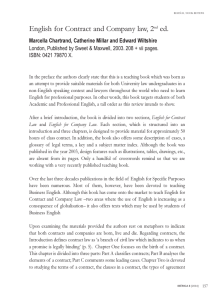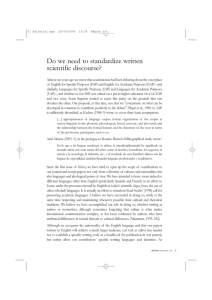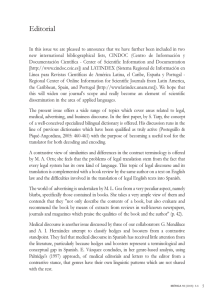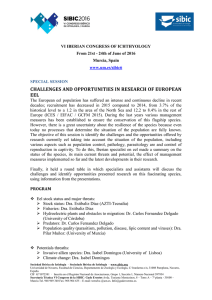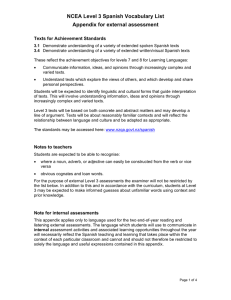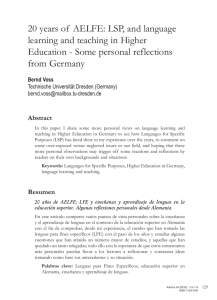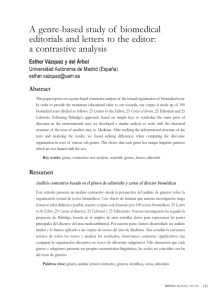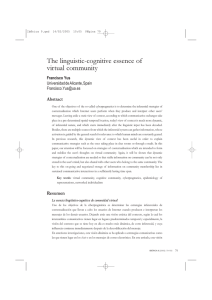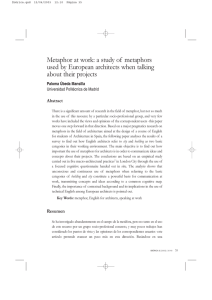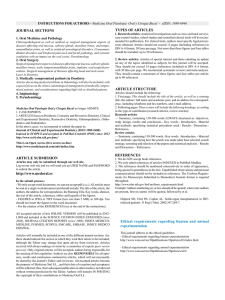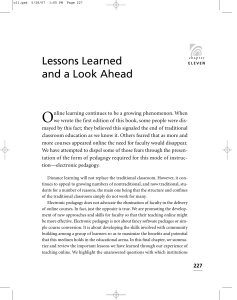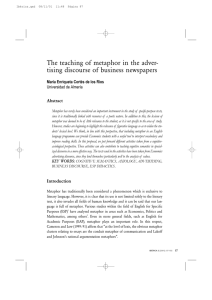Ib rica.qxd
Anuncio
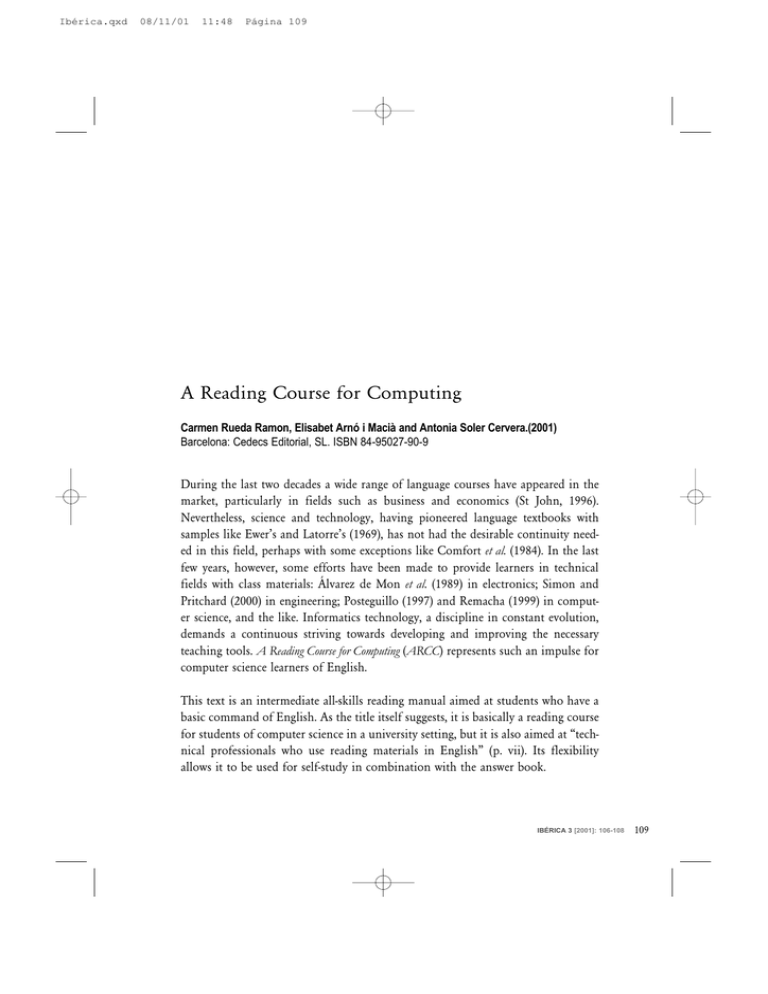
Ibérica.qxd 08/11/01 11:48 Página 109 A Reading Course for Computing Carmen Rueda Ramon, Elisabet Arnó i Macià and Antonia Soler Cervera.(2001) Barcelona: Cedecs Editorial, SL. ISBN 84-95027-90-9 During the last two decades a wide range of language courses have appeared in the market, particularly in fields such as business and economics (St John, 1996). Nevertheless, science and technology, having pioneered language textbooks with samples like Ewers and Latorres (1969), has not had the desirable continuity needed in this field, perhaps with some exceptions like Comfort et al. (1984). In the last few years, however, some efforts have been made to provide learners in technical fields with class materials: Álvarez de Mon et al. (1989) in electronics; Simon and Pritchard (2000) in engineering; Posteguillo (1997) and Remacha (1999) in computer science, and the like. Informatics technology, a discipline in constant evolution, demands a continuous striving towards developing and improving the necessary teaching tools. A Reading Course for Computing (ARCC) represents such an impulse for computer science learners of English. This text is an intermediate all-skills reading manual aimed at students who have a basic command of English. As the title itself suggests, it is basically a reading course for students of computer science in a university setting, but it is also aimed at technical professionals who use reading materials in English (p. vii). Its flexibility allows it to be used for self-study in combination with the answer book. IBÉRICA 3 [2001]: 106-108 109 Ibérica.qxd 08/11/01 11:48 Página 110 A READING COURSE FOR COMPUTING ARCC consists of 10 units focusing on a particular topic of computing; these units have been sequenced, as the authors contend, according to the progression of general computer science areas. The topics in the book can roughly be classified into two broad types: an opening unit in which the authors approach computer science from a historical point (unit 1, History of the Information Age) and a closing unit in which they speak of possible future expectations in the field (Unit 10, Challenges of the Information Age: The Internet and Beyond). The rest of units are dedicated to technical issues, such as computer architecture, software and hardware, have been organized following the guidelines provided by computer experts, who have helped [the authors] with the choice and sequencing of topics (p. viii) (units 2 [Programming Languages], 3 [Computer Architecture], 4 [Operating Systems], 5 [Databases], 6 [Artificial Intelligence], 7 [Computer Networks], 8 [Peripheral Devices] and 9 [Computer Graphics]). As would be expected in a manual of English for computer science students and professionals, the most common type of topics are by far technical. In addition, and in spite of the fact that this is always difficult to achieve in a textbook, the texts are timely and will certainly interest the students. The shortest units are fourteen pages long while the longest go up to twenty-four pages, and the number of texts included in each unit range from three to six for a total of 44 readings. ARCC does not simply present a series of readings followed by a set of questions, and its emphasis is not on teaching grammar, but rather on helping its intended users develop the four skills of reading, listening, speaking, and writing. This is shown through a well-selected series of tasks included before and after each individual text. ARCC represents a content-based approach to reading. Teaching grammar for the sake of grammar is not the primary object of this manual. Basically, and speaking of the English verb system, computer science writers would often tend to solve most of their problems expressing them in rather short sentences and simple verbal structures. As Turney (1996: 45) has put it after analyzing a series of programming language texts, the writers seem to have opted for simple, stylised use of tense. As stated above, the authors, with ample experience teaching computer science English at the university level, have organized this manual with an wide pedagogical view in mind, which will provide the readers of the different texts included a graded progression, both in terms of texts as well as in tasks, which become more 110 IBÉRICA 3 [2001]: 108-111 Ibérica.qxd 08/11/01 11:48 Página 111 A READING COURSE FOR COMPUTING demanding as the course progresses. Compared to previous textbooks on computer science English, one of the most interesting features of this manual is the neat and accurate presentation of the material, and more specifically the non-verbal material included, in terms of diagrams, charts for comprehension tasks, word-building charts, etc. The quality of this non-verbal material, or visual literacy as some would call it (Kress and Van Leeuwen, 1996), is excellent and interacts perfectly with the verbal English, thus giving the manual a professional look that immediately appeals to the reader. The units begin with a short paragraph introducing the topic featured in it, followed by an activity called preview. Through both activities the students are briefly introduced into the topic of the unit. All units contain exercises in the different skills, although predominantly reading and writing. Speaking is enhanced through other activities in the unit, particularly through those called text work and follow-up. This is complemented with comprehension tasks, such as comparing or matching text and/or pictures (for instance, true/false, multiple choice, fill in blanks, etc.), transferring information (labelling, completing diagrams, etc.) or problem-solving exercises. The text work tasks involve reorganizing paragraphs, function of passages, discourse patterns, markers, and cohesive links, etc. Finally, through vocabulary work the authors intend to foster vocabulary acquisition through the use of linguistic clues (inference, word-building, synonyms/antonyms, parts of speech) and non-linguistic clues (such as graphs, schemes, pictures, figures). Perhaps one of the limitations of this text has to do with the skill of listening. Of course there is always the media to resort to, but it would have been a big plus to this textbook to add a CD or a cassette with the audio of the texts included in the manual. This is particularly helpful when we aim at self-study, considering that the authors have this in mind. Notwithstanding this small drawback, ARCC deserves all our credit because the way it has been structured and the selection of tasks encourage students to use English in a creative way. Computer science students should welcome this text, presented in a very practical way with easy-to-follow tasks and activities that are usually required in an active and dynamic class. Furthermore, this text will provide them with language structures common in a computer science setting, which is what they are aiming at. IBÉRICA 3 [2001]: 108-111 111 Ibérica.qxd 08/11/01 11:48 Página 112 A READING COURSE FOR COMPUTING ESP instructors, experienced or not, should also welcome this textbook. Because the array of computer concepts offered are basic, it can also be used effectively by ESP teachers who have little computer science teaching preparation. In addition, Rueda Ramos et al. provide an excellent teaching tool for integrating computing concepts and language teaching with the functional use of language in relevant situations and contexts. Reviewed by Jordi Piqué Universitat de València REFERENCES Álvarez de Mon, I.; Lerchundi, M. A.; Moreno, P. (1989). English for Electronics. Madrid: McGraw-Hill. Comfort, J.; Hick, S.; Savage, A. (1984). Basic Technical English. Oxford: Oxford University Press. Ewer, J. R., and Latorre, G. (1969). A Course in Basic Scientific English. London: Longman. Kress, G. and Van Leeuwen, T. (1996). Reading Images: The Grammar of Visual Design. London: Routledge. Posteguillo, S. (1997). Network English. English in the World of Computers. Castelló: Universitat Jaume I. Remacha Esteras, S. (1999). Infotech. English for Computer Users, 2nd ed. Cambridge: Cambridge University Press. Simon, K.; Pritchard, N. (2000). Englisch für Ingenieure. Berlin: Springer. St John, M. J. (1996). “Business is booming: Business English in the 1990s.” English for Specific Purposes 15: 3-18. Turney, E. (1996). “The computer’s English”. In J. Piqué et al. (Eds.) (1996), English in Specific Settings, 39-46. València: Nau Llibres. 112 IBÉRICA 3 [2001]: 108-111
